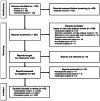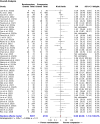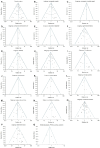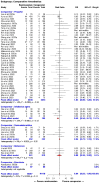Efficacy of remimazolam in preventing postoperative nausea and vomiting: a systematic review and meta-analysis
- PMID: 40784953
- PMCID: PMC12336335
- DOI: 10.1038/s41598-025-14976-z
Efficacy of remimazolam in preventing postoperative nausea and vomiting: a systematic review and meta-analysis
Abstract
This meta-analysis aimed to evaluate the efficacy of remimazolam, a newly introduced anesthetic, in preventing postoperative nausea and vomiting (PONV) compared to other anesthetics. A systematic search of studies published up to January 2024 in PubMed, Cochrane Library, and Embase was conducted to identify randomized controlled trials (RCTs) comparing remimazolam with other anesthetics in terms of PONV. Following data synthesis, outcomes were reported as the relative risk (RR) with 95% confidence interval (95% CI). Subgroup analyses were performed according to the type of comparator anesthetic. A total of 50 RCTs involving 9,193 participants were included. The results showed no significant difference in PONV incidence between remimazolam and other anesthetic agents (RR: 0.96, 95% CI: 0.80-1.13, P = 0.607). However, subgroup analysis demonstrated that a lower incidence of overall PONV was associated with remimazolam compared with inhalation anesthetics (n = 363; RR: 0.50; 95% CI: 0.34-0.73; P < 0.001). Conversely, a higher incidence of postoperative vomiting was associated with remimazolam compared with propofol (n = 3,860; RR: 1.41; 95% CI: 1.05-1.90; P = 0.024). Overall, there was no significant difference between remimazolam and other anesthetic agents in preventing PONV. However, subgroup analysis revealed that remimazolam was more effective than inhalation anesthetics in mitigating PONV, and it was inferior to propofol in preventing postoperative vomiting.
Keywords: Anesthetics; Nausea; Postoperative emesis; Postoperative nausea and vomiting; Remimazolam; Vomiting.
© 2025. The Author(s).
Conflict of interest statement
Declarations. Competing interests: The authors declare no competing interests.
Figures







Similar articles
-
Drugs for preventing postoperative nausea and vomiting in adults after general anaesthesia: a network meta-analysis.Cochrane Database Syst Rev. 2020 Oct 19;10(10):CD012859. doi: 10.1002/14651858.CD012859.pub2. Cochrane Database Syst Rev. 2020. PMID: 33075160 Free PMC article.
-
Stimulation of the wrist acupuncture point PC6 for preventing postoperative nausea and vomiting.Cochrane Database Syst Rev. 2015 Nov 2;2015(11):CD003281. doi: 10.1002/14651858.CD003281.pub4. Cochrane Database Syst Rev. 2015. PMID: 26522652 Free PMC article.
-
Aromatherapy for treatment of postoperative nausea and vomiting.Cochrane Database Syst Rev. 2018 Mar 10;3(3):CD007598. doi: 10.1002/14651858.CD007598.pub3. Cochrane Database Syst Rev. 2018. PMID: 29523018 Free PMC article.
-
Olanzapine for the prevention and treatment of cancer-related nausea and vomiting in adults.Cochrane Database Syst Rev. 2018 Sep 21;9(9):CD012555. doi: 10.1002/14651858.CD012555.pub2. Cochrane Database Syst Rev. 2018. PMID: 30246876 Free PMC article.
-
Intravenous versus inhalational anaesthesia for paediatric outpatient surgery.Cochrane Database Syst Rev. 2014 Feb 7;2014(2):CD009015. doi: 10.1002/14651858.CD009015.pub2. Cochrane Database Syst Rev. 2014. PMID: 24510622 Free PMC article.
References
-
- Colao, J. & Correa, D. R. Rapidly metabolized anesthetics: novel alternative agents for procedural sedation. J Anesth. Clin. Res7, 690 (2016).
-
- Canakci, E. et al. Prevalence study for postoperative nausea vomiting: A training hospital example. Niger J. Clin. Pract.24, 1633–1640 (2021). - PubMed
Publication types
MeSH terms
Substances
LinkOut - more resources
Full Text Sources

